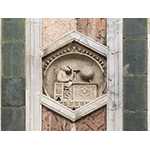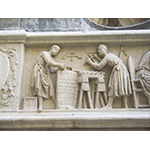Science at Places of Worship in Florence

Florentine Renaissance art contains numerous depictions that faithfully reproduce the arts and crafts of the period. These include activities tied to science, such as medicine, astronomy and geometry. The religious buildings where these depictions were sited, were themselves instruments of knowledge. Indeed, it is not rare to find churches in Florence adorned with armillas and solar quadrants.

The Monumental Complex of Santa Maria del Fiore
Places of worship are at times also places of scientific evidence, especially astronomical, as the example of Florence shows. The itinerary suggests to begin the visit with the Baptistery of San Giovanni, which houses a medieval marble artefact with the signs of the zodiac carved on it that probably made it possible to verify the course of the sun during the year.
Science and technology occupy a position of prime importance in the reliefs of Giotto’s Bell Tower, as shown by the allegories of astronomy, medicine, the building art, weaving, navigation, geometry and arithmetic (the original sculptures are in the Museo dell’Opera del Duomo). Also noteworthy are the rhombus-shaped panels on the western side of the Bell Tower, which represent the celestial bodies of medieval astronomy.
The vast interior of the Cathedral of Florence houses other material evidence alluding to the world of science. In the left aisle, beside one of the side entrances, we can admire a fifteenth-century painting by Domenico di Michelino portraying Dante and the Divine Comedy, which also documents the conception of the cosmos in the Middle Ages.
The realisation of the highest gnomon ever realised till then in a church (about 90 metres) dates to 1475. This instrument made it possible to verify the moment of the sun’s passage at the summer solstice. The hole of the gnomon is on a bronze tablet, called bronzina, at the base of the lantern of the dome. Between May and July, the rays of the sun filter through this hole and give rise to an image of the sun on the floor of the Cappella della Croce in the Cathedral, where we find the Renaissance solstice signs and the meridian altitude plotted by Jesuit scientist Leonardo Ximenes in 1755.
On the counter facade of the Cathedral, the clock by Paolo Uccello seems to ideally represent the passage from the solar clock to the mechanical clock. Consisting of a circle inscribed within a square, it is divided into 24 sectors corresponding to the hours marked with Roman numerals. A peculiar characteristic of this clock is the layout of the hours counter clockwise, starting from below, in line with a custom derived from sundials. On the external facade, in the lower left-hand corner of the cornice framing the central rose window, we see a nineteenth-century bust of Galileo with his telescope, one of the symbol-instruments of the astronomical revolution.
The Basilicas of San Lorenzo and Santa Maria Novella
Astronomy is also present in the basilica of San Lorenzo. The cupola of the Old Sacristy bears an interesting astronomical image which depicts the sky over Florence in July 1442. Given the great precision of detail, the author probably availed of the suggestions of an astronomer, perhaps Paolo dal Pozzo Toscanelli, friend of Filippo Brunelleschi.
In the second half of the 16th century, mathematician and geographer to the Grand Duke, Egnazio Danti, built an astronomical dial and two equinoctial circles on the facade of Santa Maria Novella, to study the apparent motion of the sun. Danti’s calculations were important in order to correct the calendar used till then. The new calendar, known as Gregorian after Pope Gregory XIII who promoted the reform, established that October 4, 1582 should be immediately followed by October 15, thus correcting a small error in the Julian calendar promoted by Julius Caesar. In the same church, Danti also began the construction of a monumental sundial, without completing it, however. Above the rose window in the middle of the green fascia, we can still see the gnomonic hole, through which the sun’s rays were to strike the meridian altitude on the floor inside the church.
The Monumental Complex of Santa Croce
The interior of the church of Santa Croce houses funerary monuments of illustrious figures including several well-known scientists like Galileo Galilei, Vittorio Fossombroni, Eugenio Barsanti, and Leopoldo Nobili. The monumental complex of Santa Croce is an important place for science also for the astronomical fresco inside the Pazzi Chapel, which depicts a nocturnal sky, similar to the one in the Old Sacristy in San Lorenzo.

Orsanmichele and Ognissanti
Halfway between the religious centre of Santa Maria del Fiore and the political centre in Piazza della Signoria, Orsanmichele is another example of a place of worship that also conserves an interesting document of technical-scientific iconography. In the bas-relief of the Tabernacle of the Four Crowned Saints, executed by Nanni di Banco, the Saints are depicted at work: the first on the left builds a wall; the second holds a drill and works on a column; the third with compass and square builds a capital; the last one sculpts a putto with a little pickaxe or mattock. In addition to the tools used by the saints, others hang on the wall to recreate the setting of the scene: the square, the straight-edge, the compass, and the plumb-rule. Positioned on the observer’s left, the plumb-rule makes it possible to read the inclination of the surface on which it is rested.
Orsanmichele was also suggested as a possible venue for astronomical research. In the 18th century, the Imperial Council of the Regency entrusted astronomer Tommaso Perelli with the task of evaluating the building’s suitability to become the site of an astronomical observatory. While for stability and spaciousness, the building proved suited, the same could not be said for the site: «Were the choice up to me – wrote Perelli – I would be inclined to the hill of Arcetri, a place ennobled by observations, and by the many-year sojourn of the great Galileo»
Though not a centre of scientific studies, the church of Ognissanti conserves an interesting figurative token of what a room destined to meditation and scientific speculation could have looked like between the Middle Ages and the Renaissance. A detached fresco, painted by Botticelli in 1480 and today on the right wall, depicts Saint Augustine in His Study. On the shelf behind the saint lie numerous books including an open volume with geometric figures referable to Euclid. A mechanical clock is placed in front of this book. No study could be without an armillary sphere, an astronomical instrument which usually represented the orbits of celestial bodies by means of armillas (rings) attached to a common hinge. The one depicted in the painting reflects the geocentric view of the universe in the Ptolemaic system.
****************************
Texts by Graziano Magrini
English translation by Victor Beard
Last update 09/feb/2008


